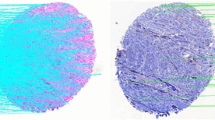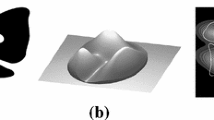Abstract
We address the problem of reconstructing a planar shape from a finite number of noisy measurements of its support function or its diameter function. New linear and non-linear algorithms are proposed, based on the parametrization of the shape by its Extended Gaussian Image. This parametrization facilitates a systematic statistical analysis of the problem via the Cramér-Rao lower bound (CRLB), which provides a fundamental lower bound on the performance of estimation algorithms. Using CRLB, we also generate confidence regions which conveniently display the effect of parameters like eccentricity, scale, noise, and measurement direction set, on the quality of the estimated shapes, as well as allow a performance analysis of the algorithms.
Similar content being viewed by others
References
R.O. Duda and P.E. Hart, Pattern Classification and Scene Analysis, Wiley-Interscience: New York, 1973.
N.I. Fisher, P. Hall, B. Turlach, and G.S. Watson, “On the estimation of a convex set from noisy data on its support function,” J. Amer. Statist. Assoc., Vol. 92, No. 437, pp. 84–91, 1997.
R.J. Gardner, Geometric Tomography, Cambridge University Press: New York, 1995.
R.J. Gardner, M. Kiderlen, and P. Milanfar, “Convergence of algorithms for reconstructing convex bodies and directional measures,” Ann. Statist., to appear.
R.J. Gardner and P. Milanfar, “Shape reconstruction from brightness functions,” in SPIE Conference on Advanced Signal Processing Algorithms, Architectures, and Implementations X, Vol. 4474, August 2001, San Diego, CA.
R.J. Gardner and P. Milanfar, “Reconstruction of convex bodies from brightness functions,” Discrete Comput. Geom., Vol. 29, pp. 279–303, 2003.
G.H. Golub and V. Pereyra, “The differentiation of pseudo-inverses and nonlinear least squares problems whose variables separate,” SIAM J. Numer. Anal., Vol. 10, pp. 413–432, 1973.
J.D. Gorman and A.O. Hero, “Lower bounds for parametric estimation with constraints,” IEEE Trans. Inform. Theory, Vol. 26. No. 6, pp. 1285–1301, 1990.
P. Hall and B. Turlach, “On the estimation of a convex set with corners,” IEEE Trans. Pattern Analysis and Machine Intelligence, Vol. 21, No. 3, pp. 225–234, 1999.
B.K.P. Horn, Robot Vision, The MIT Press: Cambridge, MA, 1986.
V. Hosel and S. Walcher, “Clustering techniques: A brief survey,” Technical Report, Institute of Biomathematics and Biometry, 2001.
S. Kay, Fundamentals of Statistical Signal Processing, Prentice-Hall: Englewood Cliffs, NJ, 1993.
A.S. Lele, S.R. Kulkarni, and A.S. Willsky, “Convex polygon estimation from support line measurements and applications to target reconstruction from laser radar data,” J. Optical Soc. Amer. A, Vol. 9, pp. 1693–1714, 1992.
S.Y.R. Li, “Reconstruction of polygons from projections,” Inform. Process. Lett., Vol. 28, pp. 235–240, 1988.
M. Lindenbaum and A. Bruckstein, “Blind Approximation of Planar Convex Sets,” IEEE Trans. Robotics and Automation, Vol. 10, No. 4, pp. 517–529, 1994.
J.J. Little, “An iterative method for reconstructing convex polyhedra from extended Gaussian images,” in Proc. AAAI National Conf. Artificial Intelligence, Washington, D.C, 1983, pp. 247–250.
S.K. Lodha and R. Franke, “Scattered data techniques for surfaces,” in Proc. Dagstuhl Conf. on Scientific Visualization, IEEE Computer Society Press, 1999, pp. 182–222.
E. Mammen, J.S. Marron, B.A. Turlach, and M.P. Wand, “A general projection framework for constrained smoothing,” Statist. Sci., Vol. 16, No. 3, pp. 232–248, 2001.
K. V. Mardia and P. E. Jupp, Directional Statistics, John Wiley and Sons: Chichester, 2000.
A. Poonawala, “Reconstructing shapes from support and brightness functions,” Masters Thesis, Computer Engineering Department, University of California Santa Cruz, 2004.
A. Poonawala, P. Milanfar, and R.J. Gardner, “A statistical analysis of shape recontruction from areas of shadows,” in 36th Asilomar Conference on Signal Systems and Computers, Vol. 1, pp. 916–920, November 2002.
J.L. Prince and A.S. Willsky, “Estimating convex sets from noisy support line measurements,” IEEE Trans. Pattern Analysis and Machine Intelligence, Vol. 12, No. 4, pp. 377–389, 1990.
A.S. Rao and K.Y. Goldberg, “Shape from diameter: Recognizing polygonal parts with a parallel-jaw gripper,” Intl. J. of Robotics Research, Vol. 13, No. 1, pp. 1637, 1994.
T.J. Richardson, “Approximation of planar convex sets from hyperplane probes,” Discrete Comput. Geom., Vol. 18, pp. 151–177, 1997.
R. Schneider, Convex Bodies: The Brunn-Minkowski Theory, Cambridge University Press: Cambridge, 1993.
P. Stoica and B.C. Ng, “On the Cramér-Rao bound under parametric constraints,” IEEE Signal Processing Letters, Vol. 5, No. 7, pp. 177–179, 1998.
J. C. Ye, Y. Bresler, and P. Moulin, “Asymptotic global confidence regions in parametric shape estimation problems,” IEEE Trans. Inform. Theory, Vol. 46, No. 5, pp. 1881–1895, 2000.
J.C. Ye, Y. Bresler, and P. Moulin, “Cramér-Rao bounds for parametric shape estimation in inverse problems,” IEEE Trans. on Image Processing, Vol. 12, No. 1, pp. 71–83, 2003.
P. Zhingeng, Z. Kun, and S. Jiaoying, “A new mesh simplification algorithm based on triangle collapses,” J. Comput. Sci. Tech., Vol. 16, No. 1, pp. 57–63, 2001.
Author information
Authors and Affiliations
Additional information
Supported in part by U.S. National Science Foundation grants CCR-9984246 and DMS-0203527.
Amyn Poonawala received the B.E. degree from the University of Mumbai, India, in 2001, and the M.S. degree from the University of California, Santa Cruz (UCSC), in 2004, both in computer engineering. He is currently pursuing the Ph.D. degree in computer engineering at UCSC. His technical interests include statistical signal and image processing and inverse problems in microlithography.
Peyman Milanfar received the B.S. degree in electrical engineering/mathematics from the University of California, Berkeley, in 1988, and the S.M., E.E., and Ph.D. degrees in electrical engineering from the Massachusetts Institute of Technology, in 1990, 1992, and 1993, respectively. Until 1999, he was a Senior Research Engineer at SRI International, Menlo Park, CA. He is currently Associate Professor of Electrical Engineering at the University of California, Santa Cruz. He was a Consulting Assistant Professor of computer science at Stanford University from 1998-2000, and a visiting Associate Professor there in 2002. His technical interests are in statistical signal and image processing, and inverse problems. He won a National Science Foundation CAREER award in 2000, was associate editor for the IEEE Signal Processing Letters from 1998 to 2001, and is a Senior member of the IEEE.
Richard Gardner holds B.Sc. and Ph.D. degrees in mathematics from University College London and was awarded a D.Sc. degree from the University of London in 1988 for contributions to measure theory and convex geometry. He has held positions at universities and research institutions in several countries and has been Professor of Mathematics at Western Washington University since 1991. He founded geometric tomography, an area of geometric inverse problems involving data concerning sections by and projections on lines or planes, and published a book on the subject in 1995.
Rights and permissions
About this article
Cite this article
Poonawala, A., Milanfar, P. & Gardner, R.J. Shape Estimation from Support and Diameter Functions. J Math Imaging Vis 24, 229–244 (2006). https://doi.org/10.1007/s10851-005-3625-z
Published:
Issue Date:
DOI: https://doi.org/10.1007/s10851-005-3625-z




